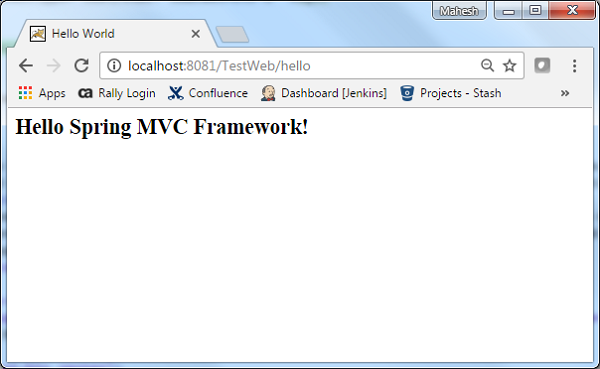InternalResourceViewResolver is used to resolve the provided URI to
actual URI. The following example show how to use
InternalResourceViewResolver using Spring Web MVC framework.
InternalResourceViewResolver allows to map web-pages with requests.
HelloController.java
Now start your Tomcat server and make sure you are able to access other web pages from webapps folder using a standard browser. Now try to access the URL http://localhost:8080/TestWeb/hello and if everything is fine with your Spring Web Application, you should see the following result:

package com.tutorialspoint; import org.springframework.stereotype.Controller; import org.springframework.web.bind.annotation.RequestMapping; import org.springframework.web.bind.annotation.RequestMethod; import org.springframework.ui.ModelMap; @Controller @RequestMapping("/hello") public class HelloController{ @RequestMapping(method = RequestMethod.GET) public String printHello(ModelMap model) { model.addAttribute("message", "Hello Spring MVC Framework!"); return "hello"; } }
<bean class="org.springframework.web.servlet.view.InternalResourceViewResolver"> <property name="prefix" value="/WEB-INF/jsp/"/> <property name="suffix" value=".jsp"/> </bean>For example, using above configuration, if URI
- /hello is requested, DispatcherServlet will forward the request to the prefix + view-name + suffix = /WEB-INF/jsp/hello.jsp.
| Step | Description |
|---|---|
| 1 | Create a project with a name TestWeb under a package com.tutorialspoint as explained in the Spring MVC - Hello World Example chapter. |
| 2 | Create a Java classes HelloController under the com.tutorialspoint package. |
| 3 | Create a view file hello.jsp under jsp sub-folder. |
| 4 | The final step is to create the content of all the source and configuration files and export the application as explained below. |
package com.tutorialspoint; import org.springframework.stereotype.Controller; import org.springframework.web.bind.annotation.RequestMapping; import org.springframework.web.bind.annotation.RequestMethod; import org.springframework.ui.ModelMap; @Controller @RequestMapping("/hello") public class HelloController{ @RequestMapping(method = RequestMethod.GET) public String printHello(ModelMap model) { model.addAttribute("message", "Hello Spring MVC Framework!"); return "hello"; } }TestWeb-servlet.xml
<beans xmlns="http://www.springframework.org/schema/beans" xmlns:context="http://www.springframework.org/schema/context" xmlns:xsi="http://www.w3.org/2001/XMLSchema-instance" xsi:schemaLocation=" http://www.springframework.org/schema/beans http://www.springframework.org/schema/beans/spring-beans-3.0.xsd http://www.springframework.org/schema/context http://www.springframework.org/schema/context/spring-context-3.0.xsd"> <context:component-scan base-package="com.tutorialspoint" /> <bean class="org.springframework.web.servlet.view.InternalResourceViewResolver"> <property name="prefix" value="/WEB-INF/jsp/" /> <property name="suffix" value=".jsp" /> </bean> </beans>hello.jsp
<%@ page contentType="text/html; charset=UTF-8" %> <html> <head> <title>Hello World</title> </head> <body> <h2>${message}</h2> </body> </html>Once you are done with creating source and configuration files, export your application. Right click on your application and use Export > WAR File option and save your TestWeb.war file in Tomcat's webapps folder.
Now start your Tomcat server and make sure you are able to access other web pages from webapps folder using a standard browser. Now try to access the URL http://localhost:8080/TestWeb/hello and if everything is fine with your Spring Web Application, you should see the following result:


No comments:
Post a Comment